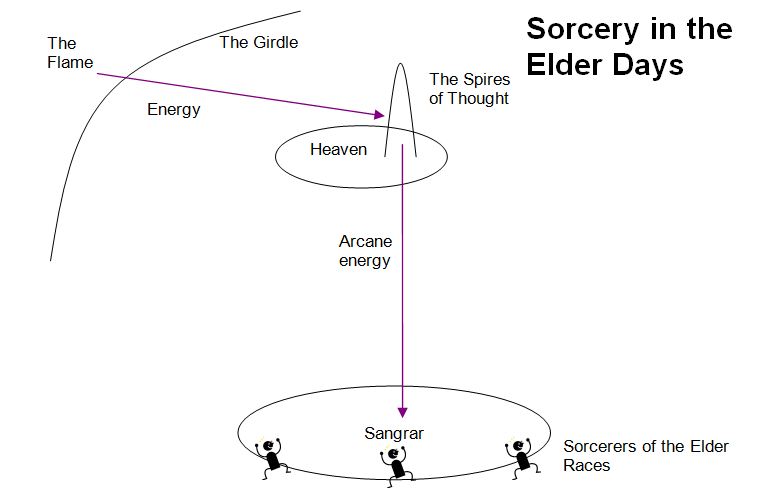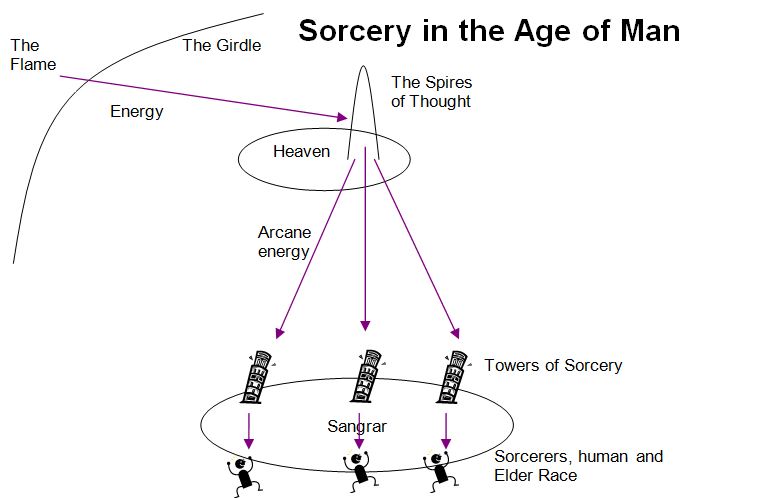Mechanics
Written below is what Harnor told the Elder Lords at the Congress of the Gods. Kandol learned it from his father, who heard it from the Firstborn, and he shared it with me:
“The Spires of Thought are the heart of sorcery. Using the Staff Sidarius, I raised them on an island in the Mere of Gems from a great crystal and consecrated them to the Girdle, linking them forever to the Flame. The Spires transform the Flame’s rays, changing them into arcane energy. As sorcerers, you absorb this energy, store it and then release it through acts of sorcery, some as simple as blowing out a candle, others powerful enough to move mountains. You and all your children will be sorcerers, and those who can draw and hold more of the Spires’ energy will be the mightiest among you.”
Sorcery’s mechanics are far simpler than earthsong’s and not much different than what Harnor laid out at the Congress. Here’s a picture, as if you need it.
Mankind was frailer than the Elder Races – those are Kandol’s words, not mine – and not built to withstand the arcane energy flowing from the Spires. So, Harnor made several towers of sorcery on Sangrar to serve as buffers between them and the Spires. Unfortunately it affected the sorcerers from the Elder Races too, though the strongest could gather energy from the Spires directly. Kandol said that he was aware of the towers, that he could feel them, but that he could push past them.
A Sorcerer’s Strength
Talent, will and mastery determined a sorcerer’s power, each contributing in different ways. Some sorcerers had immense talent and little training, others squeezed every last bit out of limited potential or studied until they had mastered the art of doing more with less. Think of a sorcerer’s power as represented by a Venn diagram of three overlapping circles, one for each leg of the tripod. The model isn’t all that different from those used in personal/career and organizational development. I’ve heard of one called the TOP model, TOP for talent, organizational need and passion, and there are others.
Talent
Four factors affected an individual’s talent:
Era – the brighter the Suns, the more powerful the sorcerers of that era. Sorcerers from before the Darkening had more talent than those born after and they, in turn, had more than those born after the Reckoning. The world milieu affected a sorcerer in two ways: the state of the Suns when he or she was born and the state of the Suns at the time of casting.
Race – every Elder Race had some talent for sorcery, based on how strong Harnor’s gift ran in them. Elves had the most talent, Ravirs the least.
Genes – Family did play a role. Those descending from a powerful Firstborn or Secondborn sorcerer tended to have more talent, just take a look at the House of Nammoran for proof. The same was true of mankind.
Luck – I used this one to explain the unexplainable, or, put another way, blame the gods. Era, race and genes alone couldn’t account for wide range of power displayed by sorcerers. There was something else, Simon Cowell might call it the X-factor, I call it the Luck of Sudnar. The gods had a hand in everything else, why not this. Certainly the Seeress wasn’t immune to nudging here or making a tweak there, if it suited her.
Talent was measured in two dimensions:
Rate – the rate at which a sorcerer could gather energy from the Spires
Capacity – a sorcerer’s internal storage capacity for the Spire’s energy
All four talent factors (era, race, genes, and luck) played into both rate and capacity.
Willpower
Pulling off a successful spell requires a certain amount of grit and determination to see it through. Tremendous willpower, the ability to concentrate on your objective during times of extreme adversity, was the hallmark of high sorcery.
Mastery
Talent and willpower could only get you so far, unless you were Nammoran the Elven Firstborn. All other sorcerers needed training, preparation and dedication to Harnor’s art to unlock the most powerful magik. You’ve heard of spells, they’re in all the wizardly tales found on the shelves in Barnes and Noble, and they were important to working magik on Sangrar too. Spells offered form and structure to the Spire’s flow, allowing a sorcerer to achieve a greater effect than would be possible through sheer talent and willpower alone.
A person with strong will could mimic the effects of a weak spell without even casting a spell or, by casting a spell, could create a more powerful effect. Someone with extraordinary will could mimic that same powerful effect with only his will or cast a spell of monumental proportion.
Sorcerers found masters to teach them spells or spend time inventing them. Only high adepts could handle enough power to cast the most powerful spells.
The House of Nammoran
Nammoran, the Elven Firstborn, rarely cast spells. Born with greater talent and will than any who would follow him, he was capable of creating epic effects with nothing more than his will and had no need for spells, even though the Harnae taught him many.
He had three sons. Indallar, the youngest, had other gifts than sorcery, but his older brother were two of the greatest sorcerers to ever wield the Spire’s power, and they couldn’t have been more different. Elras had more talent than Nammydan. His reservoirs ran as deep as Nammoran’s and he could gather enormous amounts of power, but he was neve trained by the Harnae. Nammydan, however, spent decades in the grove with the Triad and the lore gained from them made him a powerful spellcaster. He was the most learned sorcerer of the Elder
Days, and, with the massive repertoire of spells at his command, was a more powerful sorcerer than any Secondborn, even those born with more talent.
Auras
You’ve no doubt read that the Elves of the Elder Days glowed. This wasn’t the light of Heaven as some scholars speculated, though its origins were certainly divine. I mean, come on, you can’t get much more divine than the Flame! But, just blaming it on the Flame overly simplifies matters. Sorcerers were always gathering more energy from the Spires, every minute of every day, it just couldn’t be helped. The gathering rate could vary, a sorcerer reaching out to the Spires could increase his flow dramatically, but even when not actively trying, a sorcerer was still gathering. When a sorcerer gathered energy from the Spires while already at full capacity, the excess drained off, displaying as an aura.
For most people, this wasn’t an issue. As described earlier, rate and capacity were a sorcerer’s two measures of talent. Now, sorcery was commonplace in the Elder Days and all people had some modicum of talent, even if it was only enough to hold the dustpan while sweeping up. Sorcery assisted in everyday tasks, yet without any conscious thought, all but the most powerful achieved a natural state of equilibrium, using as much of the Spire’s energy as they absorbed over the course of the day.
The more powerful ones though, glowed like incandescent bulbs. At his brightest, you’d have to shield your eyes when looking at Kandol. He was a living battery, able to gather energy from the Spire’s at an astonishing rate, a rate that could replenish even his vast capacity quickly. For him, and other powerful sorcerers, it was easy to fill up. Glowing was his natural state. Fortunately, a trained sorcerer cold dampen his aura with a spell simple that using it was an autonomous function, allowing him to sleep without blinding those near him. It was difficult to keep an aura dampened while spellcasting though, so most sorcerers glowed when casting anything more than the simplest of spells.
One note – though everyone in the Elder Days could gather energy from the Spire’s, most were not considered sorcerers. That term was reserved for the small minority who studied spells. Of those, the ones who studied the most complex spells, like those the taught by the Harnae in the Grove, were the high adepts.
In the Age of Man, many sorcerer guilds existed, places where sorcerers could hone their craft. Click here to see some example sorcerer guilds.



